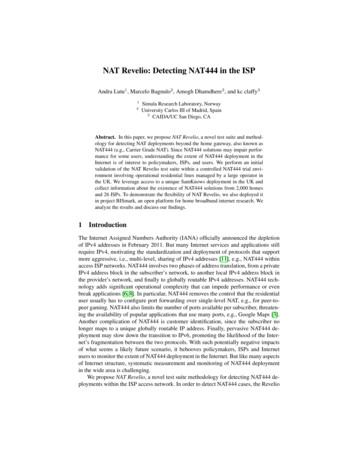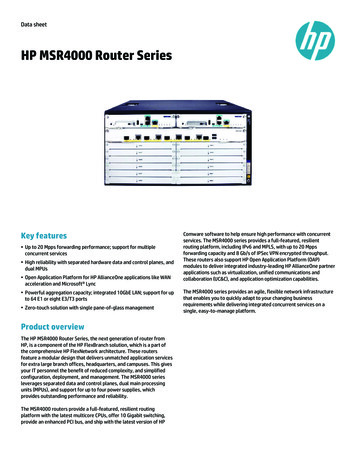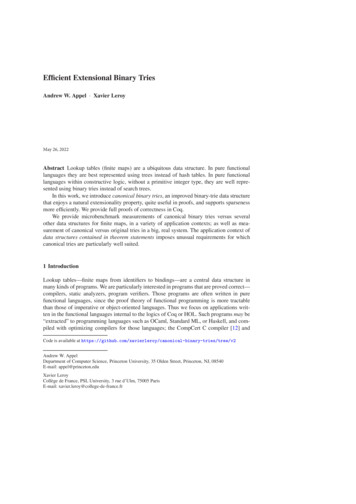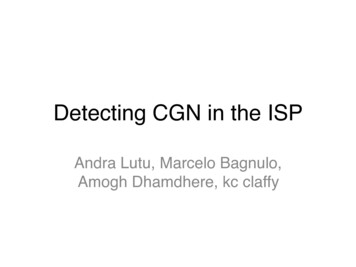
Transcription
NAT Revelio: Detecting NAT444 in the ISPAndra Lutu1 , Marcelo Bagnulo2 , Amogh Dhamdhere3 , and kc claffy312Simula Research Laboratory, NorwayUniversity Carlos III of Madrid, Spain3CAIDA/UC San Diego, CAAbstract. In this paper, we propose NAT Revelio, a novel test suite and methodology for detecting NAT deployments beyond the home gateway, also known asNAT444 (e.g., Carrier Grade NAT). Since NAT444 solutions may impair performance for some users, understanding the extent of NAT444 deployment in theInternet is of interest to policymakers, ISPs, and users. We perform an initialvalidation of the NAT Revelio test suite within a controlled NAT444 trial environment involving operational residential lines managed by a large operator inthe UK. We leverage access to a unique SamKnows deployment in the UK andcollect information about the existence of NAT444 solutions from 2,000 homesand 26 ISPs. To demonstrate the flexibility of NAT Revelio, we also deployed itin project BISmark, an open platform for home broadband internet research. Weanalyze the results and discuss our findings.1IntroductionThe Internet Assigned Numbers Authority (IANA) officially announced the depletionof IPv4 addresses in February 2011. But many Internet services and applications stillrequire IPv4, motivating the standardization and deployment of protocols that supportmore aggressive, i.e., multi-level, sharing of IPv4 addresses [11], e.g., NAT444 withinaccess ISP networks. NAT444 involves two phases of address translation, from a privateIPv4 address block in the subscriber’s network, to another local IPv4 address block inthe provider’s network, and finally to globally routable IPv4 addresses. NAT444 technology adds significant operational complexity that can impede performance or evenbreak applications [6, 8]. In particular, NAT444 removes the control that the residentialuser usually has to configure port forwarding over single-level NAT, e.g., for peer-topeer gaming. NAT444 also limits the number of ports available per subscriber, threatening the availability of popular applications that use many ports, e.g., Google Maps [3].Another complication of NAT444 is customer identification, since the subscriber nolonger maps to a unique globally routable IP address. Finally, pervasive NAT444 deployment may slow down the transition to IPv6, promoting the likelihood of the Internet’s fragmentation between the two protocols. With such potentially negative impactsof what seems a likely future scenario, it behooves policymakers, ISPs and Internetusers to monitor the extent of NAT444 deployment in the Internet. But like many aspectsof Internet structure, systematic measurement and monitoring of NAT444 deploymentin the wide area is challenging.We propose NAT Revelio, a novel test suite methodology for detecting NAT444 deployments within the ISP access network. In order to detect NAT444 cases, the Revelio
2test suite aims to determine the location of the device translating to the globally routablepublic IP address that identifies the subscriber to the global Internet. If we find that thesubscriber’s home network is not hosting this device, we conclude that the ISP deploysNAT444. Our approach relies on detecting network configuration characteristics peculiar to NAT444 deployment in an access network. We design our solution to be highlyversatile and not require prior knowledge of the setup that we are about to test. In particular, we target deployment of Revelio on large-scale measurement platforms deployedin subscriber homes, such as the SamKnows large scale measurements platform [14]and BISmark [16], an open platform for home broadband internet research.2Generic NAT444 Deployment ArchitectureWe design NAT Revelio [1] to detect a wide range of NAT444 solutions in variousconfigurations in ISPs, without any prior knowledge on the environment we test. TheRevelio client executes in a device deployed in the home network, such as a measurement device or a computer. The Revelio client performs six active tests against differentelements, including one or more servers deployed in the public Internet. In the rest ofthis section we establish the terminology we use in this paper and give an overview ofpossible NAT444 deployment architectures. We use the latter to explain how we deployNAT Revelio to detect NAT444 in the ISPs we test.There are various NAT444 implementations. We describe next the NAT444 deployment architecture in the context of DSL access technology, although this maps cleanlyto other access technologies, e.g., FTTx, cable. One type of NAT444 technology isCarrier-Grade NATs (CGN), also known as Large Scale NAT (LSN). DSL-based CGNdevices are available in three configurations: (i) stand-alone, (ii) Broadband RemoteAccess Server (BRAS) insertion-card and (iii) Core Router (CR) insertion card. Also,NAT444 deployments can be distributed (at each BRAS) or centralized (at the CR). Forsimplicity of presentation, we describe a centralized deployment of stand-alone CGNdirectly connected to the CR in the ISP access network to explain our detection approach. Other NAT444 solutions are available [15].In Figure 1, we illustrate this NAT444 architecture in DSL networks using the terminology of the IETF’s Large-Scale Measurement of Broadband Performance workinggroup (LMAP WG) reference path [4]. The path elements include:– Subscriber Device: which initiates and terminates communications over the IPnetwork. In the context of our measurement experiment this is the measurementdevice inside the subscriber’s home network that executes the Revelio client.– Private Network: a network of devices the subscriber operates in the home network, possibly using multiple layers of NAT, each operating different chunks ofRFC1918 private address space.– Service Demarcation point: where the ISP-managed service begins, usually theinterface facing the public Internet on a residential gateway or modem.– Intra IP Access: first point in the access network that uses a globally routable IPaddress.– Globally Routable Address Gateway (GRA GW): the point of interconnectionbetween ISP’s administrative domain and the rest of the Internet.
3 Subsc.deviceServiceDemarc. Intra IPAccess TransitGRAGW GRAGW Subsc.deviceServiceDemarc. GRAGW Intra IPAccess TransitGRAGW Fig. 1. Mapping between DSL access configuration and generic LMAP reference path (a) withoutNAT444 and (b) with NAT444 (in this case, a stand-alone CGN) in the access network.Figure 1 illustrates the mapping between the LMAP reference path and a standardDSL network architecture, both (a) without NAT444 (but with traditional NAT), and(b) with NAT444 technology, using a stand-alone CGN device that connects to the CR.The customer premises equipment (CPE) usually performs the NAT function, translating private addresses in the home network to public addresses in the access network.The CPE is the Service Demarcation device; its Internet-facing interface is the ServiceDemarcation point. The BRAS is the Intra IP Access point – the first point after theService Demarcation point that uses a globally routable IP address. The GRA corresponding to the subscriber maps to the IP address the ISP configures at the ServiceDemarcation point.In the NAT444 configuration in Figure 1(b) the subscriber uses private addresseswithin the home network, prior to the Service Demarcation point. For the address spaceused between the Service Demarcation point and the Intra IP Access point, the accessISP can use private, shared [18], or public (legitimate or stolen/”squat”) IPv4 addresses[3]. In this case, the Intra IP Access point maps to the NAT444 device (the stand-aloneCGN), and the GRA is the IP address at the Intra IP Access point.3NAT Revelio Test SuiteThis section describes the tests we use in the proposed test suite, and how we interpretthem to infer the presence of NAT444 solutions in access ISPs.
43.1NAT Revelio Overview and Design ChallengesBuilding a test suite for large-scale deployment of NAT444 measurements must account for possible non-standard configurations. Specifically, we need to account forcases where the subscriber deploys several levels of NAT within the home network. Inparticular, false inferences of NAT444 deployment can occur when we assume that theRevelio Client is directly connected to the Service Demarcation device when, in fact,two in-home NAT devices are in the path between the Subscriber Device and the Service Demarcation point. A naive NAT444 detection test could falsely assume that thefirst NAT device is the Service Demarcation point, and falsely map the second in-homeNAT device to an Intra IP Access point.Thus, we design NAT Revelio to operate in two phases: (i) Environment Characterization and (ii) NAT444 Detection. In the first phase, Revelio aims to establish thelocation of the Revelio Client within the home network relative to the Service Demarcation point. In the second phase, Revelio tests for the presence of NAT444 solutionsand interprets the measurement results using the environment information.NAT Revelio performs active measurements from a device running the RevelioClient in the subscriber network (see Figure 1). This step attempts to ascertain where theIPv4 address translation to the subscriber GRA occurs: in the subscriber home network(CPE) or in the ISP access network (a NAT444 device).Figure 2 depicts a flow diagram of our test methodology. When deploying Revelio,we perform all the measurements in the test suite and merge their results to make aninference regarding the existence of NAT444 in the ISP.3.2Environment Characterization PhaseIn the Environment Characterization phase Revelio runs three tests to determine theposition of the Service Demarcation point relative to the Subscriber Device running theRevelio client. This step avoids false positive inferences of NAT444 and ensure accurateresults over a wide range of in-home configurations. Figure 2 encloses the environmentcharacterization tests in green rectangles. We use the information we retrieve here tointerpret the results of the tests we run in the subsequent NAT444 Detection phase.Additionally, this phase allows us to detect the IP addresses configured in the homenetwork of the subscriber and the ones in the ISP access network.1. Identify subscriber’s GRA. First, we use the Session Traversal Utilities for NAT(STUN) [13] protocol to discover the Globally Routable Address (GRA) that corresponds to the subscriber. STUN is a standard client-server protocol that allows a user behind a NAT to learn its public mapped address. We program the Revelio client to behaveas a STUN client that queries an external STUN server (we use stun.stunprotocol.org),which replies with the GRA of the subscriber. If the ISP does not deploy NAT444 (Figure 1(a)), this GRA corresponds to the address exposed at the Service Demarcationpoint. If the ISP deploys NAT444 using a topology similar to that of Figure 1(b), thisGRA corresponds to the public IP address exposed at the Intra IP Access point alongthe reference path. This step corresponds to the very first block of the Revelio flowchartin Figure 2, labeled STUN Binding Request. The information we retrieve by performingthis action is illustrated in the flowchart by the data block labeled Subscriber GRA.
5 Fig. 2. The NAT Revelio test suite flowchart: measurement actions (sending/receiving packets)are in blue rectangles; measurement data is in green parallelograms; tests on retrieved data arein orange rhombuses. Inferences of NAT444 are in red stop blocks. We use the data we collect inphase 1 of environment characterization for all subsequent NAT detection test we run in phase 2.2. Discover home NAT device. Second, we establish whether the Service Demarcationdevice performs NAT. Specifically, we verify that the local IP address of the SubscriberDevice running the Revelio client in the home network is in private address space [12].If the IP address of the Subscriber Device is a public address, we conclude that the clientis not behind a NAT (and, implicitly, not a NAT444 device either). We further confirmthis scenario when comparing the local IP address to the GRA. If these two match,then there is no NAT device along the path. We represent this step of the EnvironmentDiscovery phase in the NAT Revelio flowchart with the test block labeled Home NATdevice. Depending on the results of the test, we include in the flowchart a stop blockwith No NAT444 (i.e., a negative result), or we move on to the next step in this phase.3. Locate Service Demarcation point [Path Analysis]. If the CPE performs NAT, we testto identify the location of the access link (i.e. the link between the Service Demarcationpoint and the first hop in the access network of the ISP) relative to the Revelio client. Weheuristically identify the access link by assuming it is the first link on the outbound pathwith a transmission latency at least an order of magnitude higher than its neighboringlinks [17].
6To quantify per-link latency we use a technique similar to pathchar [7]. Namely, weestimate per-link delay parameters by taking the minimum values of repeated RoundTrip Time (RTT) measurements with different UDP packet sizes along a path, and assuming negligible queuing and processing delays (similar to [7]). To minimize the impact of these measurements on the subscriber’s network, we gather the data by runningtraceroute hourly over a period of two days, using 21 different packet sizes varyingfrom 120 bytes to 1,400 bytes, and using as a destination a high-availability IP addressin Level 3’s network. Limiting the number of packets to 21 per test allows us to complete one run of the NAT Revelio measurements in 30 seconds. Running Revelio onceper hour for 2 days results in 48 RTT samples per TTL per packet size. We analyzethese values to estimate per-link propagation delay, and infer that the first link with aten times latency increase relative to its neighboring links is the access link. We usethe pathchar result (labeled Service Demarc. Location in the flowchart) in the tests weperform in the second phase of NAT Revelio.3.3NAT444 Discovery PhaseThis phase seeks to identify the location of the device performing NAT to the GRAmapped to the subscriber, namely before or after the Service Demarcation point. Figure 1(b) depicts the scenario with NAT444 (CGN) deployed in the DSL access ISPnetwork, after the BRAS and the Core Router. When the ISP deploys NAT444, the location of the Intra IP Access point changes compared with the case where the ISP doesnot use NAT444 (Figure 1(a)). In Figure 2, we depict enclosed in red rectangles thethree tests we run for NAT444 detection. We perform all three tests and interpret the setof results we obtain together with the information we collect in the Environment Characterization phase to make an inference regarding NAT444 deployment in the ISP wemeasure. To increase the robustness of the test suite to non-standard architectures, e.g.,when the ISP does not deploy NAT444, but configures private addresses in its accessnetwork, we assign a different confidence level to each test. One strength of Revelio liesin being able to compare the results of multiple tests for the same subscriber. To controlagainst false positives, when test results conflict, we give priority to the negative result,concluding there is no NAT444 deployment in the ISP.1. Identify private/shared addresses in the ISP access network. The first method in theNAT444 Discovery phase detects the use of private or shared IP addresses in the accessnetwork, between the Service Demarcation point and the Intra IP Access point. Figure 1(b) depicts an ISP using special address domains (i.e., private or shared addressspace) in its access network when a NAT444 solution is in place. We characterize thepath obtained by traceroutes in Phase (1), step 3, including inferring the position of theService Demarcation point. We then check if private or shared addresses are configuredalong the path toward the public Internet target which is a router inside Level3, and ifso, determine their location relative to the Service Demarcation point. This discoveryhelps us to establish if the private/shared addresses we identify are configured in theISP access network. The information allows us to correctly distinguish cases of multiple levels of NAT in the home network, which can otherwise be easily confused withNAT444 deployment. The flowchart (Figure 2) represents this step by including the data
7block labeled IP Addresses in the Access Network (which gets as input the location ofthe Service Demarcation point relative to the Revelio client) and the two following tests:Private/Shared Addresses in Access Network.Note that we assign different confidence levels to these two tests. When we observeshared address space in the ISP, beyond the Service Demarcation point, we are highlyconfident of the presence of a NAT444 solution, given that these addresses are specifically for use in NAT444 deployment. However, when we observe RFC1918 privateaddresses beyond the Service Demarcation point, we give a low confidence level to ourresults, because the ISP might use private address space for its internal infrastructurewithout deploying NAT444. Moreover, in the case where NAT Revelio does not detectany private or shared addresses past the Service Demarcation point, the test suite cannotdiscard the possibility of a NAT444 deployment in the ISP. This case can occur whenthe ISP configures public addresses (legitimate or stolen ”squat” address space) in theaccess network as part of a NAT444 deployment.42. Invoke UPnP actions. NAT Revelio runs a series of tests that aim to infer the hopcount between the Service Demarcation device and the device performing the finaltranslation to the subscriber GRA. To check if the Service Demarcation device is thedevice translating to the subscriber GRA, we verify whether the address configured onthe Service Demarcation point matches the subscriber’s GRA.If the Revelio client directly connects to the Service Demarcation device (Figure 1),we leverage the Universal Plug and Play (UPnP) IGP protocol [2] if supported by theCPE. The Revelio client sends a UPnP client control message to the CPE that retrievesthe IP Address of the WAN interface of the CPE, which, in this case, maps to the ServiceDemarcation point. In the case of a match, we infer that the ISP does not use NAT444.A mismatch between these addresses means that the ISP does indeed deploy NAT444.We give a high level of confidence to this result.Otherwise, if the Subscriber Device running the Revelio client does not connectto the Service Demarcation device, we find ourselves in a non-standard configuration,where multiple NAT devices are present within the home network. In this case, wecannot draw any conclusion regarding the presence of NAT444 in the ISP from thistest, since the UPnP test retrieves the IP address of the innermost CPE device withinthe home network, and not the IP address at the Service Demarcation point. The NATRevelio flowchart includes this set of tests, following the yes branches both for theUPnP Supported and the Revelio client connected to Service Demarcation device tests,in the NAT444 Discovery phase in Figure 2.3. Traceroute to the subscriber GRA. We also run traceroute from the Revelio clientto the subscriber GRA to measure the hop count between them. Without NAT444, theGRA is at the Service Demarcation point (Figure 1(a)), and all traceroute-respondinghops are inside the home network. With NAT444 (Figure 1(b)), the GRA is at the IntraIP Access point, which is past the Service Demarcation point. If we already know the4A common configuration is to assign private or shared address space only to the interface ofthe Service Demarcation point attached to the ISP network, while other elements of the ISPnetwork use public addresses.
8location of the Service Demarcation point relative to the Revelio client (from the firstphase), a UDP traceroute to the GRA distinguishes these two cases.We assign to the Traceroute to GRA test a high confidence level, since it relies onno CPE-specific capabilities, nor on the assumption that the ISP configures private orshared IP addresses in the access network. Nonetheless, this test still may fail to determine the presence of NAT444 in the ISP, for example when the ISP actively blocksICMP packets triggered by the traceroute. Thus, NAT Revelio cannot conclusively determine the presence of a NAT444 solution in the ISP. Figure 2 illustrates this possibilityin the NAT Revelio flowchart with the purple inconclusive stop block.44.1Validation and Large-Scale Revelio Measurement CampaignsRevelio Validation in Controlled EnvironmentWith the help of a large UK ISP operator, we tested NAT Revelio on a controlled setof subscribers included in a trial deployment of a CGN implementation of NAT444within the ISP network. The trial environment consisted of operational DSL residentiallines connected behind a stand-alone CGN NAT444 implementation. We ran the Revelioclient on 6 Subscriber Devices, 2 of which were behind the NAT444 device. We foundthat NAT Revelio accurately detected the deployment configuration of all 6 devices. Weexplain details of the test results below.After running the Environment Discovery (Section 3.2), we learned that all sixSubscriber Devices running the Revelio Client connected directly to the Service Demarcation device within the home network.For the two subscribers connected to the ISP behind a NAT444 solution, all testsin the NAT444 Discovery (Section 3.3) successfully indicated the presence of NAT444within the access network. First, after retrieving the CPE’s WAN IP address whichcorresponds to the Service Demarcation point address (as per the test we describe inSection 3.3.1), we identified it as shared address space, which is a clear symptom ofNAT444 deployment. Second, we confirmed that the subscriber GRA did not matchthe Service Demarcation point address (as per the test we describe in Section 3.3.2),reinforcing evidence of NAT444 deployment. Third, when verifying how far from theService Demarcation device the translation to GRA occurred (as per the test we describein Section 3.3.3), we measured 6 hops between the Subscriber Devices and the devicetranslating to the GRA. Only the first of these hops belonged to the home network,leaving 5 hops between the Service Demarcation device and the device performingtranslation to the GRA.NAT Revelio successfully inferred that the other 4 Whiteboxes were not behind aNAT444 solution after Invoking UPnP Actions (Section 3.3.2) and concluding that theIP addresses at the Service Demarcation point matched the GRA of the subscriber.To illustrate Revelio’s robustness to non-standard configurations, we also tested ourNAT444 detection approach on 24 residential DSL lines operated by a large Italian ISPthat does not employ NAT444 solutions in its DSL network. However, in its accessnetwork configuration, the ISP does use private IP address space for its infrastructure.This is a non-standard configuration that can wrongly mimic the presence of a NAT444
9solution in the ISP. Due to the fact that we consider multiple tests to detect NAT444in the ISP, we were able to discard such cases on the basis of conflicting results. Wefound that the first test in NAT444 Discovery (Section 3.3.1) indicated the existenceof a NAT444 solution in the ISP based on the detection of RFC1918 address spacebeyond the Service Demarcation point. Since the operator disabled UPnP on its homerouters, we could not invoke any UPnP actions (Section 3.3.2). However, tracerouteto the subscriber GRA (Section 3.3.3) showed that the GRA is, in fact, at the ServiceDemarcation point. As we mention in Section 3.3, when we have conflicting resultsfrom Revelio tests, we give priority to the negative test to avoid false negatives. Thus,we accurately concluded that the Italian ISP does not have any NAT444 deployment.4.2Large-Scale Measurement CampaignsAfter the above validation exercise, we experimented with NAT Revelio on two different large-scale measurement platforms (SamKnows’ UK deployment and BISmark),targeting multiple ISPs and potential NAT444 solutions.SamKnows Deployment. We deployed the Revelio Client on a set of SamKnows Whiteboxes within home networks in the UK. A SamKnows Whitebox is a custom hardwaredevice that residential users host voluntarily. We ran NAT Revelio from 2,000 Whiteboxes that allowed us to test 26 different ISPs for NAT444 solutions. We had no previous knowledge of the configuration of these ISPs. We collected results of tests oftwo different Revelio deployments that we performed 5 months apart, in June 2014and October 2014. Although they did not cover the same subscribers, both campaignsyielded similar results, indicating that the NAT444 deployment did not expand duringthe five-month period.The results of June 2014 campaign revealed that out of the approximately 2,000residential lines we tested, we inferred that 10 different end-users connected behind aNAT444 solution. The 10 users were spread across 5 different ISPs. Thus, the proportionof end-users we inferred were behind a NAT444 solution was 0.5% of all the residentiallines we tested. We were able to validate these findings with the operators for only forone case.5 The operator in question validated our inferences for the lines we found tobe deployed behind a NAT444 solution.Analyzing the results from the June 2014 campaign, we inferred that a total of 90%of tested end-users were not connected through a NAT444 solution (no NAT444). TheEnvironment Characterization phase of NAT Revelio helped us discard 60% of thecases of in-home cascaded NATs that would have otherwise emerged as false positives.In the NAT444 Discovery phase, the Invoking UPnP Actions test (Section 3.3.2)successfully ran on 82% of the SamKnows Whiteboxes, further identifying 81.2% ofthe tested customers as not configured to use a NAT444 solution. In the other 18%of the cases, UPnP was not supported by the home gateway, so we could not run thistest. Additionally, the Traceroute to the GRA (Section 3.3.3) independently classifiedapproximately 50% of the end-users we tested as not behind a NAT444 deployment. In5Attempting to validate our findings, we have contacted all the 5 ISPs, but we have yet to receivea reply from 4 of them.
109.5% of observed cases, we could not draw a conclusion because all tests included inthe NAT444 Discovery phase gave inconclusive results.The October 2014 deployment covered fewer subscribers (approximately 1,500 SKWhiteboxes) than the one in June 2014 (approximately 2,000 SK Whiteboxes). Wefound that 4 ISPs deployed NAT444 solutions. The results we obtained for 3 of the5 ISPs were consistent with the results we inferred of the June 2014 campaign. Wedetected one additional ISP for which the Subscriber Device (Whitebox) connecteddirectly to the Service Demarcation Device, but for which the Service Demarcationpoint address was a private (Section 3.3.2). We give high confidence to this result.6BISmark Deployment. Between 7-9 February 2015, we deployed NAT Revelio on 37OpenWRT routers that are part of the BISmark measurement platform. Our BISmarkexperiment involved fewer vantage points than our SamKnows UK experiment, butthey had much wider geographical distribution. We deployed the Revelio client in Subscriber Devices hosted in 24 different ISPs active in 13 countries distributed across thefive Regional Internet Registries (RIRs). Using the Revelio test suite, we inferred thepresence of NAT444 in three different ISPs: Vodafone for DSL customers in Italy, Embratel in Brasil and Comcast in the US. In all three cases, we inferred a NAT444 solutionby establishing the presence of RFC1918 private addresses in the ISP access network(Section 3.3.1). The traceroute to the GRA (Section 3.3.3) gave inconclusive results inall three cases. Also, in the case of Embratel and Comcast, the Revelio client could notinvoke UPnP actions (Section 3.3.2). Since an ISP may use RFC1918 addresses in theaccess network without deploying a NAT444 solution, we give low confidence to the latter two results, and mark them as potential false positives. In the case of the SubscriberDevice connected to Vodafone Italia, the Revelio client could invoke UPnP actions andverify the presence of the NAT444 solution in the ISP. We give high confidence level t
subscriber's home network is not hosting this device, we conclude that the ISP deploys NAT444. Our approach relies on detecting network configuration characteristics pecu-liar to NAT444 deployment in an access network. We design our solution to be highly versatile and not require prior knowledge of the setup that we are about to test. In partic-










